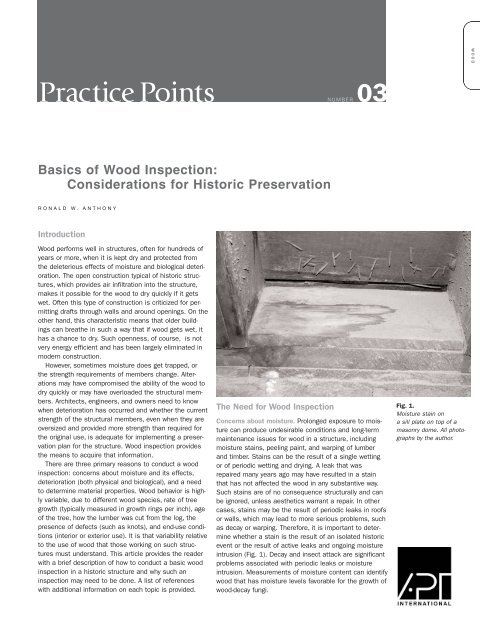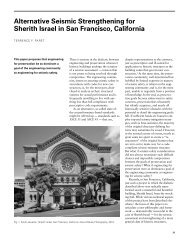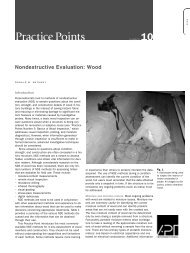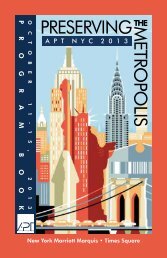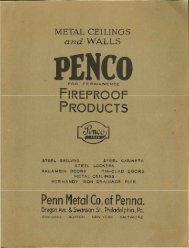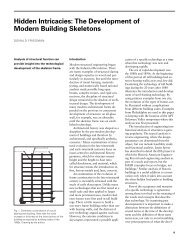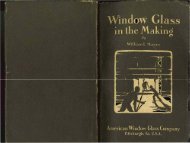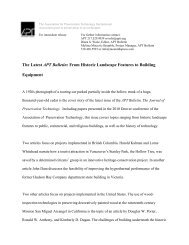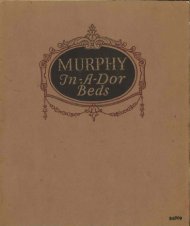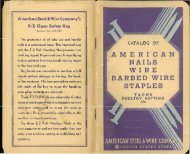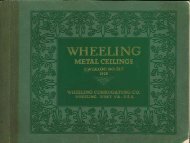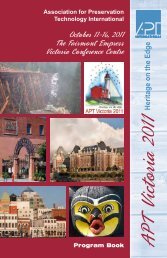Basics of Wood Inspection: Considerations for Historic Preservation
Basics of Wood Inspection: Considerations for Historic Preservation
Basics of Wood Inspection: Considerations for Historic Preservation
You also want an ePaper? Increase the reach of your titles
YUMPU automatically turns print PDFs into web optimized ePapers that Google loves.
W OODPractice PointsNUMBER03<strong>Basics</strong> <strong>of</strong> <strong>Wood</strong> <strong>Inspection</strong>:<strong>Considerations</strong> <strong>for</strong> <strong>Historic</strong> <strong>Preservation</strong>RONALD W. ANTHONYIntroduction<strong>Wood</strong> per<strong>for</strong>ms well in structures, <strong>of</strong>ten <strong>for</strong> hundreds <strong>of</strong>years or more, when it is kept dry and protected fromthe deleterious effects <strong>of</strong> moisture and biological deterioration.The open construction typical <strong>of</strong> historic structures,which provides air infiltration into the structure,makes it possible <strong>for</strong> the wood to dry quickly if it getswet. Often this type <strong>of</strong> construction is criticized <strong>for</strong> permittingdrafts through walls and around openings. On theother hand, this characteristic means that older buildingscan breathe in such a way that if wood gets wet, ithas a chance to dry. Such openness, <strong>of</strong> course, is notvery energy efficient and has been largely eliminated inmodern construction.However, sometimes moisture does get trapped, orthe strength requirements <strong>of</strong> members change. Alterationsmay have compromised the ability <strong>of</strong> the wood todry quickly or may have overloaded the structural members.Architects, engineers, and owners need to knowwhen deterioration has occurred and whether the currentstrength <strong>of</strong> the structural members, even when they areoversized and provided more strength than required <strong>for</strong>the original use, is adequate <strong>for</strong> implementing a preservationplan <strong>for</strong> the structure. <strong>Wood</strong> inspection providesthe means to acquire that in<strong>for</strong>mation.There are three primary reasons to conduct a woodinspection: concerns about moisture and its effects,deterioration (both physical and biological), and a needto determine material properties. <strong>Wood</strong> behavior is highlyvariable, due to different wood species, rate <strong>of</strong> treegrowth (typically measured in growth rings per inch), age<strong>of</strong> the tree, how the lumber was cut from the log, thepresence <strong>of</strong> defects (such as knots), and end-use conditions(interior or exterior use). It is that variability relativeto the use <strong>of</strong> wood that those working on such structuresmust understand. This article provides the readerwith a brief description <strong>of</strong> how to conduct a basic woodinspection in a historic structure and why such aninspection may need to be done. A list <strong>of</strong> referenceswith additional in<strong>for</strong>mation on each topic is provided.The Need <strong>for</strong> <strong>Wood</strong> <strong>Inspection</strong>Concerns about moisture. Prolonged exposure to moisturecan produce undesirable conditions and long-termmaintenance issues <strong>for</strong> wood in a structure, includingmoisture stains, peeling paint, and warping <strong>of</strong> lumberand timber. Stains can be the result <strong>of</strong> a single wettingor <strong>of</strong> periodic wetting and drying. A leak that wasrepaired many years ago may have resulted in a stainthat has not affected the wood in any substantive way.Such stains are <strong>of</strong> no consequence structurally and canbe ignored, unless aesthetics warrant a repair. In othercases, stains may be the result <strong>of</strong> periodic leaks in ro<strong>of</strong>sor walls, which may lead to more serious problems, suchas decay or warping. There<strong>for</strong>e, it is important to determinewhether a stain is the result <strong>of</strong> an isolated historicevent or the result <strong>of</strong> active leaks and ongoing moistureintrusion (Fig. 1). Decay and insect attack are significantproblems associated with periodic leaks or moistureintrusion. Measurements <strong>of</strong> moisture content can identifywood that has moisture levels favorable <strong>for</strong> the growth <strong>of</strong>wood-decay fungi.Fig. 1.Moisture stain ona sill plate on top <strong>of</strong> amasonry dome. All photographsby the author.
Fig. 2.Measuring the slope<strong>of</strong> a drying check on apainted column by using anacetate grid.Fig. 3.Failure <strong>of</strong> a joist in asilver-mining mill.Concerns about deterioration. Deterioration <strong>of</strong> woodcan be the result <strong>of</strong> physical processes (weathering,failure due to overload, mechanical damage, or shrinkage)or biological processes (decay and insect attack).Structural timber will typically have checks on one ortwo faces, which are due to differential shrinkage <strong>of</strong> thetimber and are part <strong>of</strong> the natural process as the wooddries (Fig. 2). A check is a separation <strong>of</strong> wood fibers ina piece <strong>of</strong> lumber, post, or timber, typically along thelength <strong>of</strong> the piece, that results from the drying <strong>of</strong> thewood after processing or installation in a structure.Checks are not a defect and do not reduce the per<strong>for</strong>mance<strong>of</strong> the piece structurally, unless two checks onopposite faces join to <strong>for</strong>m a through split. However, ifthe timber has split through the entire thickness, amore detailed investigation is necessary to determinewhether the split is a failure resulting from overload ormechanical damage or whether it is associated withshrinkage around connectors (typically bolts) (Figs. 3and 4). Differential shrinkage in mortise-and-tenonjoints can result in failure <strong>of</strong> the joint that is restrictedby the treenail (wooden peg).Weathering <strong>of</strong> wood results from cyclic wetting anddrying <strong>of</strong> the wood, exposure to ultraviolet light, and erosionby wind-blown debris, a process similar to sandblasting.Unlike decay or insect attack, weathering istypically not a significant factor in the failure <strong>of</strong> woodcomponents and the collapse <strong>of</strong> a structure. Weatheringwill change the appearance <strong>of</strong> wood, but theprocess is so slow that failure <strong>of</strong> components due todecay generally occurs long be<strong>for</strong>e weathering becomesa major factor in the failure. Weathering seldom damagesthe wood enough to require replacement, with theexception <strong>of</strong> shingles and cladding. Weathered wood is<strong>of</strong>ten considered aesthetically pleasing (Fig. 5).Biological deterioration is generally caused by fungalor insect attack. Bacteria can degrade wood but aregenerally not a concern with historic structures becausedecay fungi and insects tend to impact material propertiesmore rapidly than bacteria. Thus, the focus <strong>of</strong> awood inspection <strong>for</strong> biological deterioration is typicallyfungi or insect activity.All wood is subject to a variety <strong>of</strong> deterioration mechanisms,the most prevalent being wood-decay fungi,which can ultimately lead to the inability <strong>of</strong> structuralmembers to per<strong>for</strong>m. Depending on wood species, largetimbers will retain moisture internally, frequently causinginterior rot with no visible sign <strong>of</strong> the deterioration onthe surface <strong>of</strong> the wood. Moisture absorption thoughend grain, checks, or holes provides a highly favorableenvironment <strong>for</strong> decay fungi to attack the heartwood atthe center <strong>of</strong> a large timber. The heartwood (the innergrowth rings <strong>of</strong> the tree) typically has more decay resistancethan the sapwood (the outer growth rings <strong>of</strong> thetree). However, even the heartwood <strong>of</strong> naturally durablespecies such as chestnut will decay when exposed toenough moisture. Deterioration is a particular concernwhere the wood is in contact with the ground or withother materials, such as porous masonry, that mayallow <strong>for</strong> moisture to be absorbed into the wood.Fungi associated with wood include mildew and stainand decay fungi. Fungi propagate from spores presentin the air. Mildew grows on the surface <strong>of</strong> wood andpaint and does not affect the strength <strong>of</strong> the wood.Stain fungi (not to be confused with moisture stains)penetrate the surface <strong>of</strong> the wood but do not reduce itsstrength. Decay fungi, however, break down wood componentsover time. All types <strong>of</strong> decay fungi — brown rot,white rot, and dry rot — affect the ability <strong>of</strong> wood toper<strong>for</strong>m its intended function. Although identifying thespecific fungus during wood inspection is not essential,identifying the location and extent <strong>of</strong> deterioration dueto decay fungi is important.Generally, if the moisture content <strong>of</strong> the wood is lessthan 20 percent, fungi are unable to grow. Areas withmoisture contents between 20 and 30 percent can supportthe growth <strong>of</strong> fungi, but the moisture may not besufficient to support long-term active decay. Moisturecontents between 30 and 40 percent are highly favorable<strong>for</strong> active fungal growth and are <strong>of</strong>ten an indication<strong>of</strong> advanced decay, with symptoms that may includeinternal voids and surface deterioration. Highly saturatedwood (with more than 60 to 80 percent moisturecontent) typically has insufficient oxygen <strong>for</strong> fungus togrow; there<strong>for</strong>e, the decay may be inactive. Insects generallyrequire that moisture be greater than 10 percentto be active and deteriorate the wood. In addition t<strong>of</strong>avorable moisture content, both fungi and insectsrequire suitable temperature and oxygen, as well as thewood as a food source. However, moisture is the controllingfactor <strong>for</strong> decay in historic structures.The early stage <strong>of</strong> decay, known as incipient decay, ischaracterized by discoloration and an initial loss <strong>of</strong>2 PRACTICE POINTS 03
integrity <strong>of</strong> the wood. No voids are present. Probing withan awl or a screwdriver may reveal that the surface <strong>of</strong>the wood is s<strong>of</strong>t or punky. As the decay progresses, thewood integrity deteriorates until small voids develop.This stage is termed intermediate decay. The smallvoids continue to extend primarily along the wood grain,where it is easier <strong>for</strong> moisture to move through thewood, but can also extend across the grain. Larger voidsdevelop where the decay originated, and the boundaries<strong>of</strong> the decay continue to extend, reducing the integrity <strong>of</strong>the wood and compromising its structural capacity (Fig.6). At this advanced stage, termed advanced decay, simpleprobing with an awl or a screwdriver is unlikely todetect the hidden deterioration in internal voids. Anincrement borer or a portable hand drill may be used toexamine wood removed from the interior <strong>of</strong> larger timbers.However, more advanced techniques, such asresistance drilling, are able to quantify the extent <strong>of</strong>deterioration rather than simply identify its presence.Termites and wood-boring insects reduce the crosssection <strong>of</strong> a wood member by either digesting or tunnelingthrough the wood. Subterranean and drywood termitesdigest the wood as they move below the surface<strong>of</strong> the wood. Termites can <strong>of</strong>ten be detected through thepresence <strong>of</strong> mud tubes on the exterior <strong>of</strong> either thestructure or the individual wood members. The tubesallow the termites to maintain a favorable moisture environmentas they move towards a new food source.<strong>Wood</strong>-boring beetles create holes that are packed withfrass (the byproduct <strong>of</strong> the tunneling process). Carpenterants and bees leave large clean tunnels in affectedwood.With decay, there is a definite progression from soundwood to punky wood to a total loss <strong>of</strong> wood fiber, i.e., avoid. Unlike decay, insect damage tends to have anabrupt transition between affected and unaffected areas<strong>of</strong> the wood. <strong>Wood</strong> that has not been penetrated byinsects retains its structural integrity, although there canbe a loss <strong>of</strong> cross section. The loss <strong>of</strong> cross sectiondirectly relates to the load-carrying capacity <strong>of</strong> the memberby reducing the volume <strong>of</strong> wood available to carryloads. The reduction in cross section, if known, can betaken into account by engineers to determine whetherthe affected member can still carry the required loads orneeds to be rein<strong>for</strong>ced or replaced. For both types <strong>of</strong>deterioration, moisture is generally required, and theresult is a loss <strong>of</strong> integrity <strong>of</strong> the wood member, as wellas a loss <strong>of</strong> cross section (Fig. 7).Concerns about material properties. Material propertiesare important when wood components carry loads. Todetermine whether the existing wood can carry therequired structural loads, it is important to know theappropriate strength and stiffness properties <strong>of</strong> thewood. Identification <strong>of</strong> the wood species is also animportant factor, not only to calculate its strength andstiffness but also to determine whether there will be significantdifferential shrinkage if other woods are used <strong>for</strong>repairs.Although some individuals can identify wood speciesin the field using a hand lens, the most reliable meansto accurately identify species is done by examininganatomical features <strong>of</strong> the wood under a microscope.Individuals who want to learn how to identify woodspecies themselves can purchase wood samples andidentification handbooks. <strong>Wood</strong> scientists and wood conservatorswill identify wood species <strong>for</strong> a fee. The U.S.Forest Products Laboratory in Madison, Wisconsin, willidentify up to five samples without charge, but it typicallytakes several weeks to get the results.For new wood construction, structural engineers relyon design values referenced in building codes to determinean acceptable species, size, and grade <strong>for</strong> a particularload condition. For existing buildings, engineers<strong>of</strong>ten rely on current building codes and standards todetermine adequacy <strong>of</strong> the wood members. However,current standards are generally based on lower-qualitymaterial than what is found in many historic structures.Since many older buildings were constructed be<strong>for</strong>ebuilding codes or design values <strong>for</strong> wood products wereestablished (and, thus, be<strong>for</strong>e grade stamps were used),engineers inexperienced with historic structures or materialsare <strong>of</strong>ten in a quandary when determining whatdesign values are appropriate. Frequently a species andgrade are assumed, leading to wood members beingdeclared structurally deficient. The result is <strong>of</strong>ten anoverly conservative estimate <strong>of</strong> design values andunnecessary replacement, repair, and retr<strong>of</strong>it decisions,with the associated unnecessary project costs.Although estimates <strong>of</strong> strength and stiffness can bemade by knowing the species, establishing the grade,and there<strong>for</strong>e the design properties, is more involved. Insitugrading should not be conducted unless the individualis familiar with the appropriate standards and hasFig. 4.Split between boltscaused by wood shrinkage.Fig. 5.Weathered cladding,considered aestheticallypleasing.PRACTICE POINTS 03 3
Fig. 6.Decayed beam supportinga timber column.Fig. 7.Insect damage on a porchbeam, as evidenced by theyellow frass from powderpost beetles.Fig. 8.Awl inserted to probe theinterface between a timberbeam and a masonry wall.the knowledge <strong>of</strong> how grades are established within thedesign codes.Tools <strong>for</strong> Basic <strong>Wood</strong> <strong>Inspection</strong>There are three “tools” <strong>for</strong> a basic wood inspection:visual inspection, a sharp probe, and a moisture meter.Equipment used <strong>for</strong> nondestructive evaluation can givemuch more in<strong>for</strong>mation about wood condition, but theuse <strong>of</strong> such tools should be reserved <strong>for</strong> situationswhere a basic inspection cannot sufficiently answer thequestions <strong>of</strong> the architect, engineer, or owner. An individualexperienced in wood inspection may also use ahammer <strong>for</strong> sounding or a portable hand drill to gainin<strong>for</strong>mation about the relative condition <strong>of</strong> the wood,although neither <strong>of</strong> these methods allows <strong>for</strong> quantifyingthe extent <strong>of</strong> deterioration: they are best suited <strong>for</strong>identifying locations that warrant further investigation.A sharp probe will also not allow <strong>for</strong> quantifying theextent <strong>of</strong> deterioration in larger members, but it easilydetects areas <strong>of</strong> surface deterioration and should beincluded in any wood-inspection tool kit.A visual inspection allows <strong>for</strong> identifying componentsthat are missing, broken, or in an advanced state <strong>of</strong>deterioration. Missing components are those that havebeen removed or have fallen away, frequently due toextensive deterioration. If missing components wereintended to provide structural support or protectionfrom the elements (e.g., to prevent moisture intrusion),their replacement may be essential to prevent long-termdamage to the structure. This problem <strong>of</strong>ten manifestsas ro<strong>of</strong> leaks in historic buildings. A small mirror with atelescoping handle and a flashlight are useful wheninspecting relatively inaccessible areas.Visual inspection also allows <strong>for</strong> the detection <strong>of</strong>past or current moisture problems as evidenced bymoisture stains on the exposed surface <strong>of</strong> the wood.Further, visual inspection enables detection <strong>of</strong> externalwood-decay fungi or insect activity as determined by thepresence <strong>of</strong> decay fruiting bodies, fungal growth, insectbore holes, mud tubes, or wood removed by wooddestroyinginsects. Visual inspection provides a rapidmeans <strong>of</strong> identifying areas that may need further investigation.Probing the wood with a sharp pick or an awl enablesrapid detection <strong>of</strong> voids in the wood that may not bevisible on the surface. Internal decay is <strong>of</strong>ten maskedby the lack <strong>of</strong> evidence on the exposed surface <strong>of</strong> thewood. For advanced decay where large internal voidsare present near the surface, probing can detect evidence<strong>of</strong> potentially serious deterioration. For internalvoids in large timbers more advanced inspection methodsare generally required to detect the void. Even <strong>for</strong>the early stage <strong>of</strong> decay, probing can reveal areas thathave experienced sufficient deterioration due to decayfungi by allowing <strong>for</strong> easy entry <strong>of</strong> a sharp probe, althoughno void is yet present. <strong>Wood</strong> without incipientdecay tends to <strong>of</strong>fer more resistance to probing, due toits higher density and more intact internal wood structure(Fig. 8).The true moisture content <strong>of</strong> wood can be determinedonly by oven drying a sample removed from astructure. However, portable moisture meters usingelectrical capacitance or electrical conductance can displaythe approximate moisture content <strong>of</strong> wood.Capacitance-type meters measure the electrical fieldwithin a small area <strong>of</strong> a piece <strong>of</strong> wood (Fig. 9). They donot require penetration <strong>of</strong> probes into the wood andgenerally provide the average moisture content throughouta certain depth, typically less than an inch; however,a wet surface (e.g., rain on a window sill) can dramaticallyaffect the reading. These meters are particularlyuseful <strong>for</strong> measuring the moisture content <strong>of</strong> interiorand exterior woodwork (doors, windows, trim, etc.) anddimension lumber.For thicker material, such as structural timber, a conductancemeter, <strong>of</strong>ten called a resistance moisture4 PRACTICE POINTS 03
meter, will provide a better indication <strong>of</strong> the internalmoisture content. A conductance-type meter conductselectric current through wood between two probes (Fig.10). The probes, which come in different lengths, can beinserted into the wood to various depths, thus allowing<strong>for</strong> determining the moisture content at different depths<strong>of</strong> larger timbers. This technique is useful in determiningwhether wood is drying or taking up moisture.Advanced Investigative TechniquesIn the interest <strong>of</strong> saving the maximum amount <strong>of</strong> historicfabric while not altering or scarring the materialsduring investigative probes, preservationists <strong>of</strong>ten lookto nondestructive testing methods to answer questionsabout the evaluation and identification <strong>of</strong> materials, conditions,and alterations made to structures over time.However, they are not part <strong>of</strong> a basic wood inspectionand are not generally needed <strong>for</strong> most wood assessments.When the in<strong>for</strong>mation revealed from a basicinspection is insufficient to make in<strong>for</strong>med decisions,then advanced investigative techniques should be considered.Only a few nondestructive techniques haveproved useful in historic-preservation projects. The mostcommonly used methods are:Fig. 9.Capacitance-type moisturemeter being used on windowsill.Fig. 10.Conductance-type moisturemeter being used on a timbercolumn in contact withthe ground.Fig. 11.Timber sill and wood claddingin contact with stonefoundation.• stress-wave analysis, used to locate advanceddecay• resistance drilling, used to quantify the loss <strong>of</strong>material due to decay or insect damage• digital radioscopy, used to view hidden conditionsand constructionWhere to LookDetermining the condition <strong>of</strong> wood components is themost common reason <strong>for</strong> conducting an inspection.Knowing what parts <strong>of</strong> a structure to inspect and whattools to use depends on the goal <strong>of</strong> the inspection. Theinspection should begin with looking <strong>for</strong> problems wherethey are most likely to occur in a structure. Missing orfailed components, moisture stains, the presence <strong>of</strong> fungalfruiting bodies, decayed wood, insect bore holes,mud tubes, or frass are indicators that need closerinvestigation. An inspection should focus on likely problemareas, such as:• wood in contact with the ground• wood that exhibits moisture stains• wood with visible decay• ro<strong>of</strong> penetrations, such as around chimneys and vents• attic sheathing, framing lumber, and timbers• sill beams and wall plates, particularly when they arein contact with masonry• floor joists and girders, particularly where they rest onexterior walls• openings (doors and windows)• material interfaces, such as wood and masonry,particularly beam pockets (Fig. 11)• exterior woodwork, including cladding, shingles, ands<strong>of</strong>fits• porches• crawl spaces and basements• areas <strong>of</strong> the structure that have been alteredIt is essential to remember that the purpose <strong>of</strong> theinspection is to provide data that can be used to answerquestions raised by the architect, engineer, or ownerabout the condition <strong>of</strong> the wood. If the wood has moisturestains, are the stains recent, as indicated by highmoisture-content readings, or is the wood sufficiently drythat the stain likely occurred long ago? If decay is present,can it be active, as indicated by moisture-contentreading greater than 20 percent, or is the decay fungusdormant? Are splits due to normal drying checks, or is itan indication <strong>of</strong> failure <strong>of</strong> that component? If so, wasthe failure due to loads exceeding the capacity overtime, or could it be due to a one-time occurrence? Theinspector should ask these types <strong>of</strong> questions. Soundtechnical data about the current condition <strong>of</strong> the woodare necessary <strong>for</strong> effective repair and replacementPRACTICE POINTS 03 5
decisions to be made. Such data are the result <strong>of</strong> athorough wood inspection.RONALD W. ANTHONY, wood scientist <strong>for</strong> Anthony andAssociates, Inc., received M.S. and B.S. degrees in woodscience and technology from Colorado State University.He focuses on assessment <strong>of</strong> timber structures. In 2002he received the James Marston Fitch Foundation Grant <strong>for</strong>his approach to evaluating wood in historic buildings.Additional ReadingAnthony, Ronald W. “Condition Assessment <strong>of</strong> Timber UsingResistance Drilling and Digital Radioscopy.” APT Bulletin 35, no. 4(2004): 21–26.American Society <strong>of</strong> Civil Engineers. Evaluation, Maintenance andUpgrading <strong>of</strong> <strong>Wood</strong> Structures: A Guide and Commentary. New York:American Society <strong>of</strong> Civil Engineers, 1982.American Society <strong>of</strong> Civil Engineers. Guideline <strong>for</strong> StructuralCondition Assessment <strong>of</strong> Existing Buildings. Reston, Va: AmericanSociety <strong>of</strong> Civil Engineers, 2000.Beckman, P. Structural Aspects <strong>of</strong> Building Conservation. London:McGraw-Hill Book Co., 1994.Charles, F. W. B., and M. Charles. Conservation <strong>of</strong> Timber Buildings.Dorset, England: Donhead Publishing Ltd., 1984.Collings, J. Old House Care and Repair. Lower Coombe, England:Donhead Publishing Ltd., 2002Evers, C. The Old-House Doctor. <strong>Wood</strong>stock, N.Y.: Overlook Press,1986.Feilden, B. M. Conservation <strong>of</strong> <strong>Historic</strong> Buildings. Ox<strong>for</strong>d andBoston: Reed Educational and Pr<strong>of</strong>essional Publishing Ltd., 1994.Forest Products Laboratory, Forest Service and U.S. Dept. <strong>of</strong>Agriculture. <strong>Wood</strong> Handbook: <strong>Wood</strong> As An Engineering Material.Washington, D.C.: U.S. Government Printing Office, 2000.Friedman, D. The Investigation <strong>of</strong> Buildings: A Guide <strong>for</strong> Architects,Engineers, and Owners. New York: W. W. Norton and Co., 2000.Harris, S. Y. Building Pathology: Deterioration, Diagnostics, andIntervention. New York: John Wiley and Sons, 2001.Hoadley, R. B. Identifying <strong>Wood</strong>: Accurate Results with Simple Tools.Newtown, Ct.: Taunton Press, 1990.Hoadley, R. B. Understanding <strong>Wood</strong>: A Craftsman's Guide to <strong>Wood</strong>Technology. Newtown, Ct.: Taunton Press, 2000.Hutchins, N. Restoring <strong>Wood</strong>en Houses. Buffalo: Firefly Books,1999.Larsen, K. E., and N. Marstein. Conservation <strong>of</strong> <strong>Historic</strong> TimberStructures: An Ecological Approach. Ox<strong>for</strong>d: Butterworth-Heinemann,2000.Nash, G. Renovating Old Houses. Newtown, Ct.: Taunton Press,1992.Newman, A. Structural Renovation <strong>of</strong> Buildings: Methods, Detailsand Design Examples. New York: McGraw-Hill, 2001.Oliver, A., J. Douglas, and J. S. Stirling. Dampness in Buildings.2nd ed. Ox<strong>for</strong>d: Blackwell Science Ltd., 1997.Panshin, A. J., and C. de Zeeuw. Textbook <strong>of</strong> <strong>Wood</strong> Technology,Vol. 1. New York: McGraw-Hill Book Co., 1970.Pellerin, R. F., and R. J. Ross. Nondestructive Evaluation <strong>of</strong> <strong>Wood</strong>.Madison, Wisc.: Forest Products Society, 2002.Ridout, B. Timber Decay in Buildings: The Conservation Approach toTreatment. London: E. and F. N. Spon, 2000.Robson, P. Structural Appraisal <strong>of</strong> Traditional Buildings. Hants,England: Gower Technical, 1991.Robson, P. Structural Repair <strong>of</strong> Traditional Buildings. Dorset,England: Donhead Publishing Ltd., 1999.Ross, P. Appraisal and Repair <strong>of</strong> Timber Structures. London: ThomasTel<strong>for</strong>d Ltd., 2002.Ross, R. J., B. K. Brashaw, X. Wang, R. H. White, and R. F. Pellerin.<strong>Wood</strong> and Timber Condition Assessment Manual. Madison, Wisc.,Forest Products Society, 2004.Singh, J., ed. Building Mycology: Management <strong>of</strong> Decay and Healthin Buildings. London: E. and F. N. Spon, 1994.Watt, D. S. Building Pathology Principles and Practice. Ox<strong>for</strong>d:Blackwell Science, 1999.Watt, D., and P. Swallow. Surveying <strong>Historic</strong> Buildings. LowerCoombe, England: Donhead Publishing Ltd., 1996.Weaver, M. E., and F. G. Matero. Conserving Buildings: Guide toTechniques and Materials, Revised Edition. New York: John Wileyand Sons, 1997.Williams, R. S., M. T. Knaebe, and W. C. Feist. Finishes <strong>for</strong> Exterior<strong>Wood</strong>: A Comprehensive Guide to the Painting/Staining andMaintenance <strong>of</strong> Homes, Decks, Log Structures and More. Madison,Wisc.: U. S. Dept. <strong>of</strong> Agriculture, Forest Products Laboratory, 1996.Practice Points presents basic in<strong>for</strong>mation on technical topicsrelated to preservation practice as an introduction <strong>for</strong>those new to the field or as a refresher <strong>for</strong> more seasonedpr<strong>of</strong>essionals.© 2007 by the Association <strong>for</strong> <strong>Preservation</strong> TechnologyInternational. This Practice Point originally appeared inVol. XXXVIII, No. 2-3, <strong>of</strong> the APT Bulletin, The Journal <strong>of</strong> <strong>Preservation</strong>Technology. Reprint requests should be submittedin writing to the Association <strong>for</strong> <strong>Preservation</strong> TechnologyInternational, 3085 Stevenson Drive, Suite 200, Springfield,IL 62703, or to info@apti.org.The Association <strong>for</strong> <strong>Preservation</strong> TechnologyInternational3085 Stevenson Drive, Suite 200Springfield, IL 62703217.529.9039fax (toll free) 888.723.4242administration@apti.orgwww.apti.org


